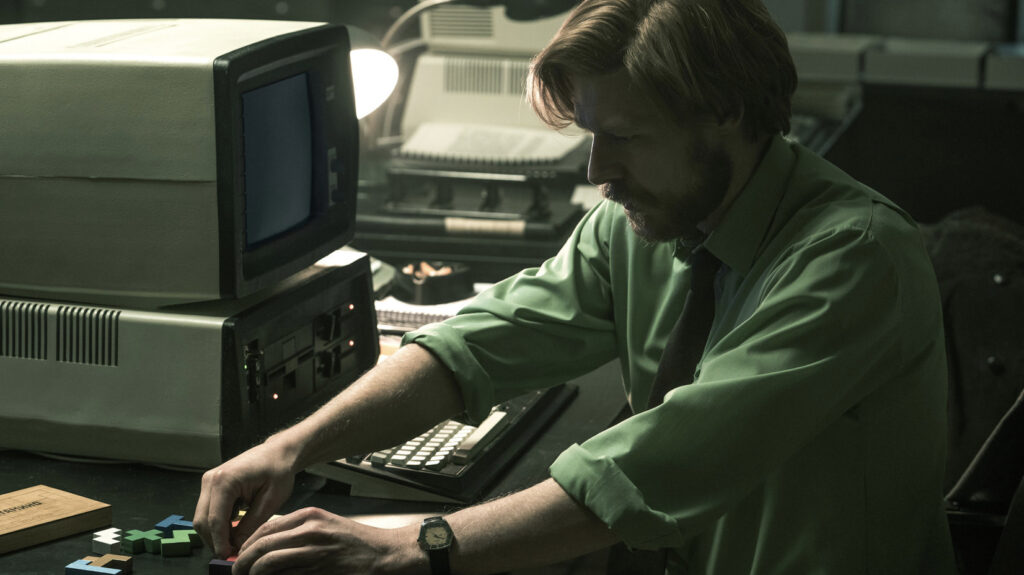
To this day I can remember sitting at the school lunch table days after my birthday in 1989. It was just a few months after the launch of the Nintendo Gameboy, and I was lucky enough to get one as my big birthday present. Talking to my friends as we ate our nutritious pizza squares we could not stop talking about the amazing puzzle game that came packaged with the system; Tetris. While people are used to the addictive nature of puzzle games these days on their cell phones, the phenomenon that was Tetris was a new sensation for the time. Little did we know, the story of what it took to get the game into our hands was almost too insane to believe.
As founder of the videogame company, Bullet-Proof Software, Henk Rogers (Taron Egerton) is always searching for the next big game. While promoting his version of the Chinese board game, Go, at that year’s CES (Consumer Electronics Show), Henk is introduced to Tetris. The game was created by Alexey Pajitnov (Nikita Yefremov), a Russian programmer who has no intention or no knowledge his game reached regions outside Russia. Searching to gain the rights to sell Tetris to Japanese markets, Henk learns the rights to the game are tied up between multiple parties and the Government run organizations in Russia are not in a rush to hand out the rights to sell such a hot commodity to capitalist countries. Getting the go ahead to release Tetris to the world would become a political hotbed of espionage and intrigue.

While the actual events of the history of Tetris are a tangled web of political cold war games, this is a gussied up Hollywood version of true events. All government agencies from ELORG (the state owned “corporation” that handles all electronic dealings of Russia) to the KGB certainly did have their hands in the negotiations and handling of the Tetris property, the deep threat action origins that peek their head in and out of the film’s runtime are overly embellished if not totally made up. All of this can be expected from a movie making stand-point. It is hard to fault the movie for its choices in making the events of these transactions more thrilling than they may have been, but a more interesting story is left behind in its wake.
I first learned of the history of Tetris from the YouTube channel, Gaming Historian, created by Norman Caruso. It is an in depth mini-documentary that illustrates the background of all the main players, including the mysterious past and creation of ELORG and the full history of Pajitnov and his creation of the game and how it spread around the world. But this is where the film makes its big mistake. The story deserved to be told with Pajitnov as the protagonist. In real life (from what I know), Henk Rogers is a good man. Sure, he started his venture into getting the rights to Tetris with the idea it would make tons of money, he genuinely is a good human being. And the film doesn’t paint him as a bad person, but making his journey to make money as the genesis of the storytelling process paints an disingenuous picture.

Pajitnov had dreams of making video games, but living under the oppressive fist of the Soviet Union, made this only ever feel like a dream.
Though just hinted at by the film, the man never made a single dime off Tetris, even after its massive success in the worldwide market. That did change in 1996 (with Henk’s help), but this information is an afterthought for the film, where the journey with Pajitnov from start to finish is a more heartwarming and interesting story that could have been told without loosing the political mind games between Henk, Russia, and the other publishers fighting for control. It also would have been just as impactful without relying on out of the woods ar chases trying to replicate Argo instead of staying true to the story.
Pacing in general is an issue with Tetris. It starts by trying to make Henk’s background story some fast paced thrill ride through a torturous exposition dump highlighted by employing random inserts of 8-bit graphics that only happens at the start and end of the film, leaving for an uneven presentation. And if we are being super nit-picky, why in his summation of popular Nintendo games they show accurate representations of Super Mario Brothers and Metroid, did they use a clip of The Legend of Zelda: The Four Swords? The game came out nearly 15 years after the events of the story. Did they have permission to use clips of some games, but not the original The Legend of Zelda? Super odd.
Tetris is not a band film. The pieces are all there, they have just been arranged in a strange way.
To save time, they also make it seem that just looking at Tetris turns people’s minds to mush as they can’t believe its utter beauty. Playing Tetris is what gets you hooked; not looking at it. Keeping audiences entertained is important.
But you don’t need thrills and action to do it. Much like Tetris itself, this should have been a film that looks like it couldn’t have been that interesting, but once you start, it grabs your attention and never lets go.
Final Grade: B-

Check out more of Matthew’s articles.
Here’s the trailer of the film.

